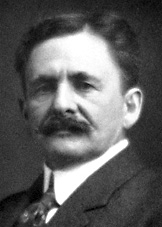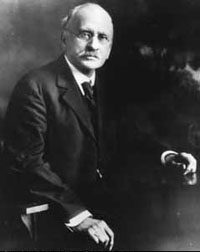Albert A. Micheleson & Edward W. Morley
Created by Adrienne Dooley
In 1887, Albert A. Michelson and Edward W. Morley performed what is now considered one of the most famous failed experiments.
Personal Life
Albert A. Michelson

Albert A. Michelson was born on December 19, 1852 in Strelno, Prussia. Following high school graduation he was appointed to the United States Naval Academy by President Grant. After a two-year cruise in the West Indies he taught physics and chemistry at the United States Naval Academy. After leaving the military, he continued his educations, studying at the Universities of Berlin and Heidelberg, and the College de France and Ecole Polytechnique in Paris. In 1883, he accepted a position as Professor of Physics at the Case School of Applied Science in Cleveland, Ohio, where he performed the Micheleson-Morley experiment. In 881 he invented the interferometer to discover the effect of the Earth's motion on the observed velocity, used in the Michelson-Morley experiment and allowed for greater accuracy in measuring distances using the length of light-waves. Following his employment at Case, he taught physics at both Clark University and the University of Chicago, becoming the Head of Department at the later. In 1907 he was the first American to win a Nobel prize in science, winning the Nobel Prize in Physics for his studies on the velocity of light. He rejoined the Navy from 1918-1929, resigning to work at the Mount Wilson Observatory in Pasadena, California. Micheleson was president of the American Physical Society (1900), the American Association for the Advancement of Science (1910-1911), and the National Academy of Sciences (1923-1927). He received many awards throughout his career, including the Matteucci Medal from the Societa Italiana in 1904, the Copley Medal from the Royal Society in 1907, the Elliot Cresson Medal from the Franklin Institute in 1916, the Medal of the Royal Astronomical Society in 1923, and the Duddel Medal from the Physical Society in 1929. Some of his most famous published works include Velocity of Light in 1902, Light Waves and Their Users in 1899, and Studies in Optics in 1927. Michelson also measured the diameter of the star Betelgeuse - the first accurate determination of the size of a star. He married Edna Stanton of Lake Forest, Illinois in 1899. The couple had four children.
Edward W. Morley

Edward W. Morley was born January 29, 1838 in Newark, New Jersey and was raised on Connecticut and Massachusetts. He was graduated from Williams College in 1860. He began his career with the ministry and worked in the United States Sanitary Commission and taught eleven different subjects at the South Berkshire Institute. He earned honorary masters and doctorate degrees from Cleveland Medical Colleges and Wooster College respectively. He accepted a position as Instructor of Chemistry, Geology, Natural History, and Mathematics at Western Reserve College in Hudson, Ohio and in 1869, following a Congregational pastorate in Ohio. He remained as an emeritus professor until 1906. Between 1873 and 1888 Morley also taught at the Cleveland Medical School. Aside from the Michelson-Morley experiment, he worked researched the determination of molecular weights using "wet chemistry." His research on the atomic weight of oxygen provided a new standard for chemistry and to this date the accuracy of his analysis has not been superseded by chemical means. He published his value for the relative atomic weight of oxygen as 15.879, with the scale of hydrogen equal to 1, in 1895 in the Smithsonian Institution Contributions to Knowledge no. 980. He was president of both the American Chemical Society (1899-1900) and the American Association for the Advancement of Science (1896) as well as named to the National Academy of Sciences and the American Academy of Arts and Sciences. He was also made an honorary member of the Royal Institution, the Chemical Society of London, and the British Association for the Advancement of Science. Morley published fifty-six scientific papers throughout his career. In 1907 he received the Davy Medal of the Royal Society. He was married to Isabella Birdsall.
Michelson-Morley Experiment
Background
In the 19th century, scientists believed in the existence of a luminiferous ether, a medium in which light waves could flow through across the Earth's surface. This belief come from the fact that other waves, such as water waves and sound, must move across a medium, water and air respectively. There must, therefore, be a medium between the earth and the sun that was transparent (not readily observable). Assumptions of this ether include that it was stationary and that it filled all of space. In 1887, Michelson and Morley set up an experiment to prove that an ether existed and to understand its motion relative to the Earth. The purpose of the experiment was to study the speed of light in different directions. This would allow Michelson and Morley to measure the speed of the ether relative to the Earth, therefore proving its existence.
Experimental Set-Up
A modified version of the Michelson's inferferometer was used in their experiment. The components of the device included: a light source, a half-silvered glass plate, two mirrors, and a telescope. The mirrors were placed perpendicularly to each other at an equal distance from the glass plate. The glass plate was set at a forty-five degree angle to the two mirrors. The mirrors were mounted to a base that rotated freely on a basin filled with liquid mercury (reduce friction). The orientation of the device allowed Michelson and Morley to measure the speed of light in different directions. Their hypothesis was that light will travel faster along the arm of the device oriented in the same direction as the ether was moving and slower if oriented in the opposite direction.
Results
No discernible fringes were detected. Fringes would indicate a different speed of light depending on the orientation and/or position of the Earth in its orbit around the sun. If there was a dependence on position/orientation of the Earth relative to the sun for light, crests and troughs of light waves in each arm of the device would arrive and interfere out of synchronization.
Connectedness
The Michelson-Morley experiment is one of the most famous examples of how much a "failed" experiment can contribute to the scientific community. Also, there is are still some people who still believe in the existence of an ether. There are still studies performed to look for differences in the speed of light in different directions. To this date, no one has found a case in which the speed of light in a vacuum is different.
History
In 1895, Hendrik Antoon Lorentz introduced a length contraction equation. He believed that the null result obtained in the experiment was cased by an effect of contraction made by the ether on their apparatus. The equation was the first in a sequence of equations that later led to a new branch of physics: special relativity popularized by Albert Einstein. Albert Einstein's Theory of Relativity was based on the null result achieved by Micheleson and Morley and replaced Lorentz's length contraction equation.
Further reading
http://galileoandeinstein.physics.virginia.edu/more_stuff/flashlets/mmexpt6.htm Simulation of the Michelson-Morley experiments - including the non-existent ether wind. http://newt.phys.unsw.edu.au/einsteinlight/jw/module3_M&M.htm A quantitative explanation of the Michelson-Morley experiemnt
External links
References
All images and information included in the page come from the following resources: http://scienceworld.wolfram.com/physics/Michelson-MorleyExperiment.html https://www.aps.org/programs/outreach/history/historicsites/michelson-morley.cfm http://www.nobelprize.org/nobel_prizes/physics/laureates/1907/michelson-bio.html http://www.acs.org/content/acs/en/education/whatischemistry/landmarks/atomicweightofoxygen.html http://www.britannica.com/biography/Edward-Williams-Morley http://newt.phys.unsw.edu.au/einsteinlight/jw/module3_M&M.htm